6. That Ferris wheel is called what?
The Question
Disney California Adventure offers one of the most memorable panoramic reveals in any Disney Park: emerging from the densely forested Grizzly Peak, guests get a stunning glimpse across the choppy waters of Paradise Bay where an elegant Victorian boardwalk of criss-crossed Edison bulbs, clapboard siding, and turn-of-the-century towers await. A gleaming white wooden roller coaster darts along the shores, while an enormous Ferris wheel rotates along the water’s edge.
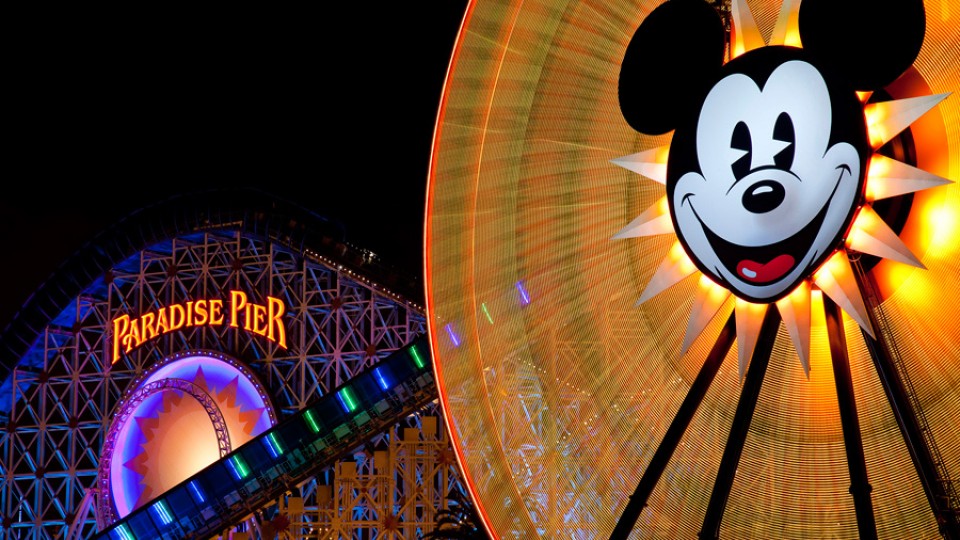
Of course, since this is Disneyland, that Ferris wheel is adorned with the giant, smiling face of Mickey Mouse presented in his classic “pie-eyed” style. Imagine your surprise when you check the park map to find that this colorful attraction is called… The Pixar Pal-a-Round?!
The Answer
As part of Disney California Adventure’s never-ending metamorphosis, the park’s icon has been in a constant state of flux. When it opened in 2001, the park’s icon was meant to be the (aptly named) Sun Icon, a metal sculpture of radiating bronze spires. More fit for a mall than for a position opposite Sleeping Beauty Castle, the Sun Icon lost its duties to the faux Grizzly Peak. But the forced perspective mountain was oddly positioned (to benefit guests of the Grand Californian Hotel) and failed to resonate as a visual anchor.
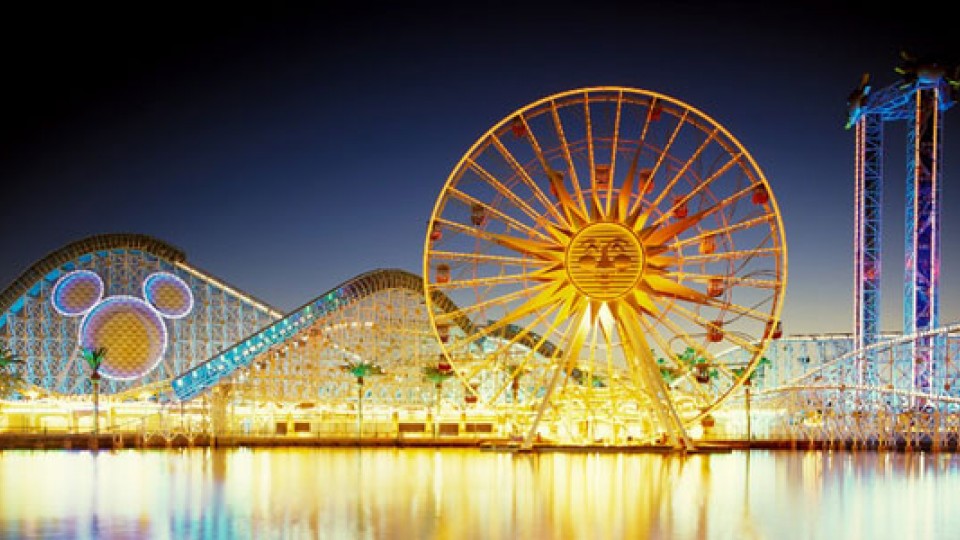
In 2009, the “reimagined” Paradise Pier opened as the first step in the park’s rebirth. The “Sun Wheel” that once lorded over the lagoon had been a problem, representing all that guests disliked about the park. Its replacement was Mickey’s Fun Wheel, outfitting the classic amusement with the tried-and-true face of Mickey in a historic, pie-eyed form perfect for the pier’s new timeline. Even when the park’s real icon, the Carthay Circle Theater, joined in 2012, the silhouette of Mickey’s Fun Wheel was still used to instantly communicate Disney California Adventure and its new direction.
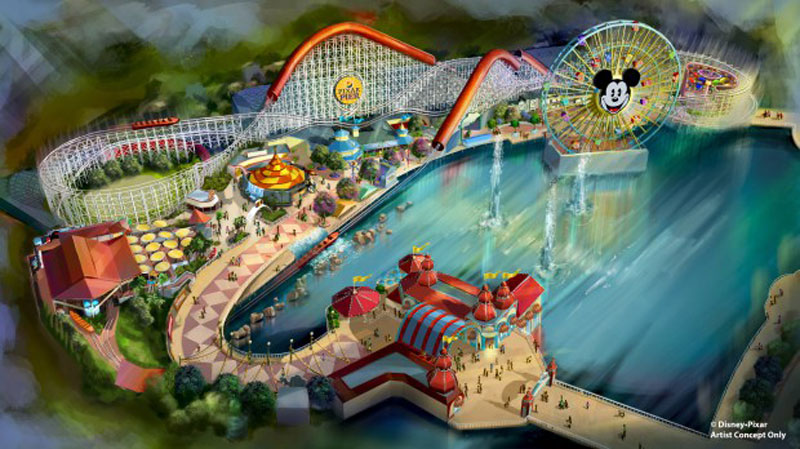
Then, in 2018, Imagineers swept through Paradise Pier with yet another reimagining. The curious result – Pixar Pier – mashes the Victorian styling with disconnected Pixar movies in four “neighborhoods” dedicated to The Incredibles, Inside Out, Toy Story, and… well… other. Part of that last section includes the Ferris wheel. Though it continues to feature a ‘30s-style pie-eyed Mickey on its face, the wheel is curiously called the Pixar Pal-a-Round.
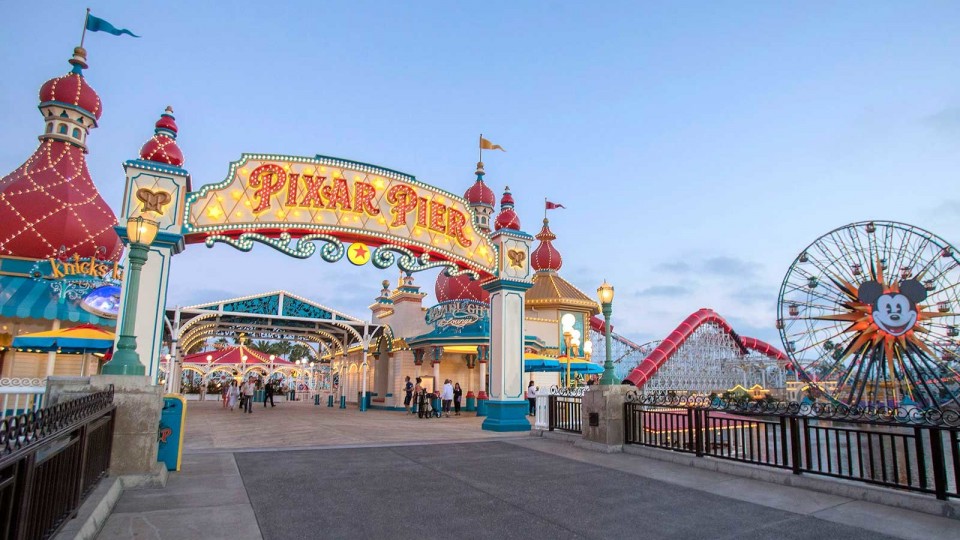
Initial art suggests Disney planned to replace Mickey’s face with Pixar’s familiar “Luxo ball” (a yellow ball with a blue stripe and red star), but Disney’s research must’ve indicated that Mickey’s face was too beloved to lose. Even still, calling the ride “The Color Wheel” or “Disney’s Wheel of Color” might be a more logical (and less anachronistic) alternative. The unusual sight of classic Mickey looming over Pixar Pier is far from the weirdest inconsistency in the creatively questionable land, but it’s certainly the largest.
7. Who cares about popcorn buckets, mugs, and spirit jerseys this much?
The Question
If you happened to swing by Walt Disney World on October 1, 2021 – the launch of the resort’s 50th Anniversary celebration – you would’ve seen something very unusual: most of Magic Kingdom’s rides were walk-ons.

Despite ostensibly being the biggest promotion in the history of the resort, much of the shine cooked up for “The Most Magical Celebration on Earth” took the form of collectible shirts, tumblers, pins, mugs, and more, all swathed in glittering royal blue and rainbow “EARidescence” – Disney’s decreed color palate of the year, mixing gold with a wash of multi-color, glistening like a gasoline spill.
In fact, lines for limited edition merchandise and food snaked through Magic Kingdom, even as guests walked right onto Space Mountain and Big Thunder Mountain without so much as a pause. Reports of screaming matches and even physical fights accompanied images of packed gift shops, empty shelves, and guests carrying wagons of 50th Anniversary merchandise out of the Emporium and back to their cars before breakfast time.
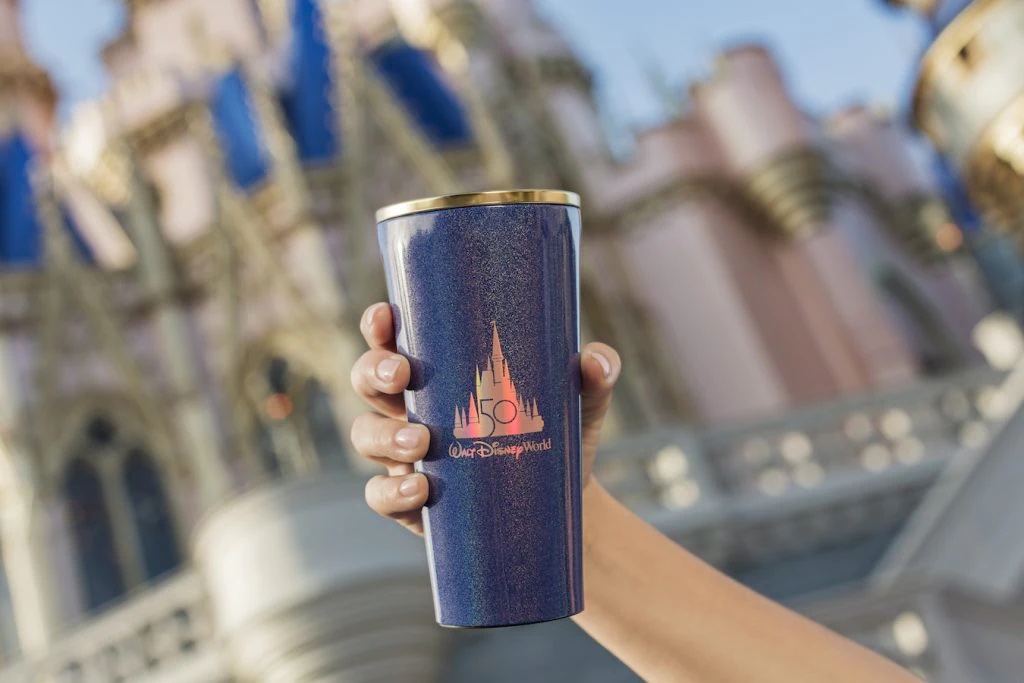
Obviously, the events of October 1 represent a condensed and pressurized version of typical shopping patterns at Disney Parks… but even a “standard” day will reveal lines for simple, plastic souvenirs and inexplicable guests walking around with trash bags carrying dozens of identical stuffed animals! So it’s pretty natural to ask, What’s the deal with DIsney Parks merchandise, and who really needs that many royal blue spirit jerseys?
The Answer
In 2018, a corporate restructure saw Disney’s theme park division “fuse” with its licensing and merchandising division, becoming the slightly-dystopian and overtly commercial Disney Parks, Experiences, and Products juggernaut. While that merger was definitely a landmark moment in the “merchandization” of Disney Parks, it wasn’t the start.
There’s always been a market for Disney Parks merchandise and collectibles. But especially in the last twenty years, two very important ingredients have come together.
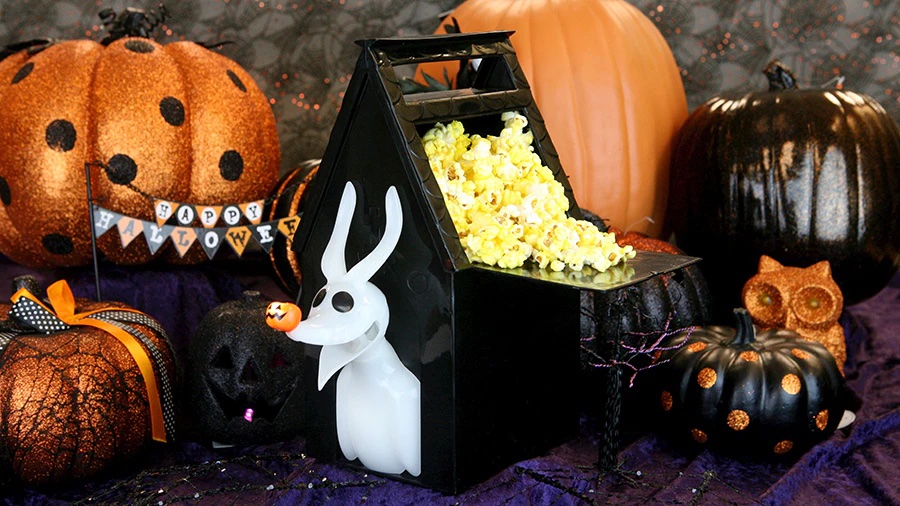
First, there’s the rise of the “lifestyler” – a subset of guests with Annual Passes who frequent Walt Disney World and (especially) Disneyland so regularly that for them, Main Street has become the new mall; a place where you meet up with friends after work just to relax. These are the guests who, it’s often said, stop by “just for dinner” at EPCOT, or swing by Disneyland on the way home from work to stake out a spot for Fantasmic. (The same spots, mind you, that once-in-a-lifetime guests can’t afford to waste a whole evening reserving.)
Especially since about 2005 (when Disneyland’s 50th Anniversary promotion and post-9/11 tourist boom returned Disney Parks to pop culture prominence), the rise in “lifestylers” has become a green light for Disney to market merchandise that’s limited edition, seasonal, or otherwise exclusive. “Lifestylers” can afford to spend an hour waiting in a 100-person line at a popcorn booth, eager to snag a Nightmare Before Christmas popcorn bucket for $29.99; an exclusive, seasonal pin; a shirt decrying the latest “glowing away” of the Lost Legend: The Main Street Electrical Parade.
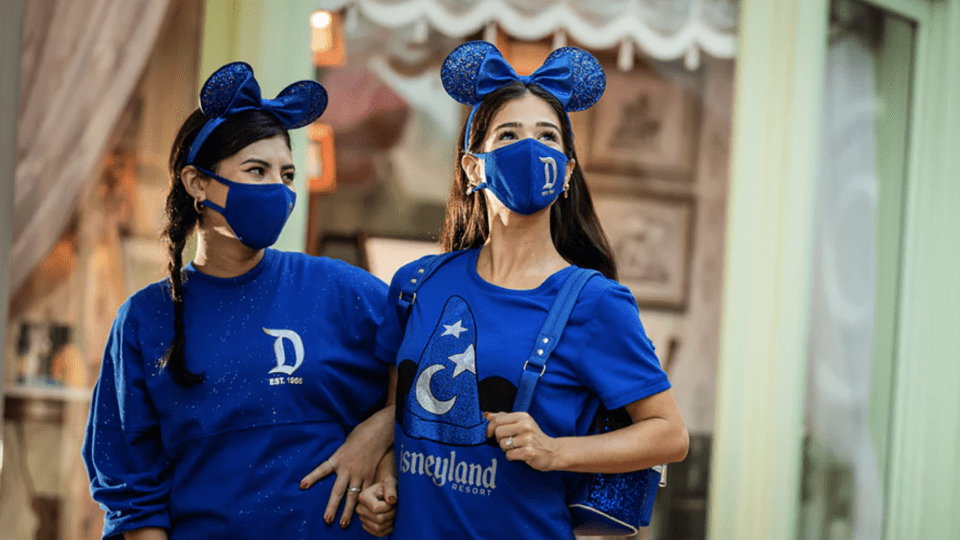
There’s really nothing objectively wrong with a subset of Disney Parks fans becoming “lifestylers,” nor in Disney creating a merchandise market tailor made for them. Limited, seasonal souvenirs are quite literally designed to be impulse buys that then disappear, so of course folks are excited to jump into whatever Disney decrees the year’s cutest color of Mouse Ears, or a light-up popcorn bucket, or a spirit jersey, or a Loungefly backpack. It’s all a part of the lifestyle, and some very nice collectibles have been a result!
It’s the second ingredient here that’s the problem: the Internet. The early-2000s rise of Ebay was probably the first domino that lead to today’s merchandise “black market” – a massively frustrating system that Disney has total-ability, but little-interest in regulating.
Despite setting “2 per guest” limits on in-demand items, Disney’s SKU barcode system essentially allows guests to buy two of every size or style of a release, at every shop, for every member of their party. (The belief among fans is that, frankly, Disney doesn’t care who buys their consumer products, because hey, 10 shirts sold is 10 shirts sold, whether it’s to one person or ten.)
As the first guests checked out of the Emporium on October 1, 2021 – visitors captured images of dozens of guests who immediately laid their newly-bought, limited edition merchandise out on Main Street to get photos for Ebay, uploading the listings the second they owned the item, or even using Disney promotional photos to upload the auction before even having the item in-hand.
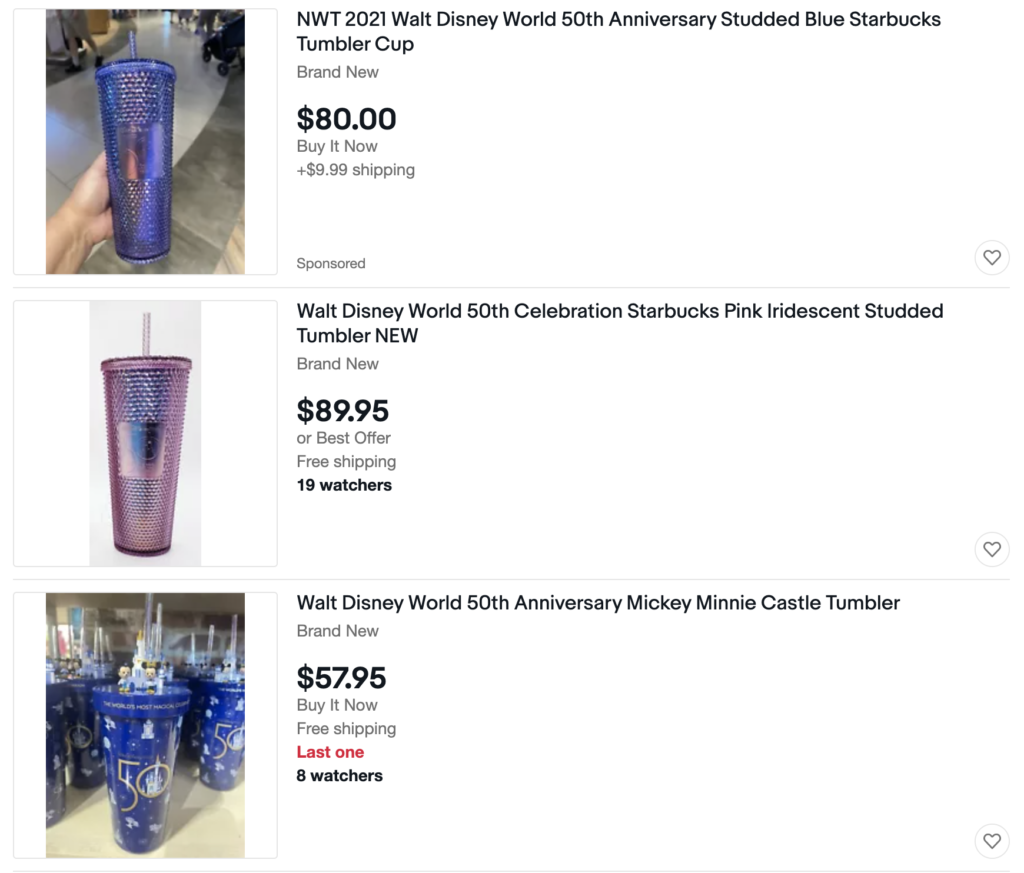
A staggering “black market” of Disney merchandise resellers has popped up around limited-edition collectibles – Loungefly backpacks, spirit jerseys, popcorn buckets, stuffed animals, MagicBands, tumblers… You name it, they’ll buy it.
Skirting rules, breaking the terms of their Annual Passes, and taking advantage of Disney’s lax enforcement, resellers sweep through Disney gift shops buying limited merchandise en masse with the explicit intention to sell $30 t-shirts for $50, $60, $80 or more under the guise of being “personal shoppers.” (You’ve gotta admit – it takes serious chuzpah to walk out of the park lugging trash bags filled with in-demand merchandise, crossing your fingers that you can sell it for three, five, ten times its retail value online.)
In November 2021, RunDisney athletes collectively rallied to bring attention to “scalpers” who swept through the event’s pre-run Expo to buy out race merch and resell it to non-runners. When high-profile resellers who were involved suddenly closed up shop soon after, the consensus was that Disney had at last revoked their Annual Pass (which prohibits the re-sale of merchandise bought an AP discount) and even banned them from property. It seemed that at last, Disney would get serious about the issue.
But remember those $30 Figment popcorn buckets? When they launched at EPCOT just a few months later, images of guests carrying ten or more out of the park spread through social media, earning the ire of guests in line, at home, and planning future trips, aghast that Disney would sell out the stock to resellers without a care. Within hours, literally hundreds of them appeared on Ebay, many fetching prices well over $100 or even $200.
Look – we don’t judge. If you’re into collecting theme park merchandise, we’re all about it. (Also, shameless plug to support fan-made artists as well – even by supporting Park Lore for just $24 a year or buying our hand-drawn designs in the Park Store!) But like so many aspects of Disney Parks fandom, it’s fair that outsiders might find a little unbelievable that anyone would find a popcorn bucket worth waiting eight hours for – much less fist-fighting for or paying scalpers hundreds of dollars for.


